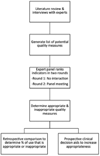Identification of Quality Measures for Performance of and Interpretation of Data From Esophageal Manometry
- PMID: 26499925
- PMCID: PMC4993017
- DOI: 10.1016/j.cgh.2015.10.006
Identification of Quality Measures for Performance of and Interpretation of Data From Esophageal Manometry
Abstract
Background & aims: Esophageal manometry is the standard for the diagnosis of esophageal motility disorders. Variations in the performance and interpretation of esophageal manometry result in discrepant diagnoses and unnecessary repeated procedures, and could have negative effects on patient outcomes. We need a method to benchmark the procedural quality of esophageal manometry; as such, our objective was to formally develop quality measures for the performance and interpretation of data from esophageal manometry.
Methods: We used the RAND University of California Los Angeles Appropriateness Method (RAM) to develop validated quality measures for performing and interpreting esophageal manometry. The research team identified potential quality measures through a literature search and interviews with experts. Fourteen experts in esophageal manometry ranked the proposed quality measures for appropriateness via a 2-round process on the basis of RAM.
Results: The experts considered a total of 29 measures; 17 were ranked as appropriate and were as follows: related to competency (2), assessment before the esophageal manometry procedure (2), the esophageal manometry procedure itself (3), and interpretation of data (10). The data interpretation measures were integrated into a single composite measure. Eight measures therefore were found to be appropriate quality measures for esophageal manometry . Five other factors also were endorsed by the experts, although these were not ranked as appropriate quality measures.
Conclusions: We identified 8 formally validated quality measures for the performance and interpretation of data from esophageal manometry on the basis of RAM. These measures represent key aspects of a high-quality esophageal manometry study and should be adopted uniformly. These measures should be evaluated in clinical practice to determine how they affect patient outcomes.
Keywords: Esophageal Manometry; High-Resolution Manometry; Quality Measures; RAND/UCLA Appropriateness Methodology.
Copyright © 2016 AGA Institute. Published by Elsevier Inc. All rights reserved.
Conflict of interest statement
The authors have no other reported disclosures or conflicts of interest.
Figures
References
-
- Gyawali CP, Patel A. Esophageal motor function: technical aspects of manometry. Gastrointest Endosc Clin N Am. 2014;24:527–543. - PubMed
-
- Gyawali CP, Bredenoord AJ, Conklin JL, et al. Evaluation of esophageal motor function in clinical practice. Neurogastroenterol Motil. 2013;25:99–133. - PubMed
-
- Fox MR, Pandolfino JE, Sweis R, et al. Inter-observer agreement for diagnostic classification of esophageal motility disorders defined in high-resolution manometry. Dis Esophagus. 2014 - PubMed
-
- Fox MR, Bredenoord AJ. Oesophageal high-resolution manometry: moving from research into clinical practice. Gut. 2008;57:405–423. - PubMed
Publication types
MeSH terms
Grants and funding
LinkOut - more resources
Full Text Sources
Other Literature Sources



